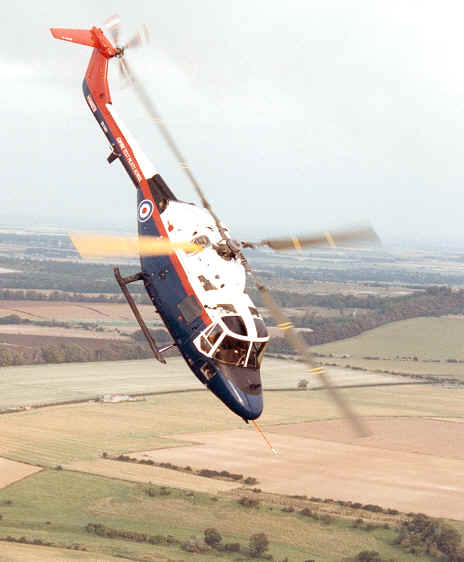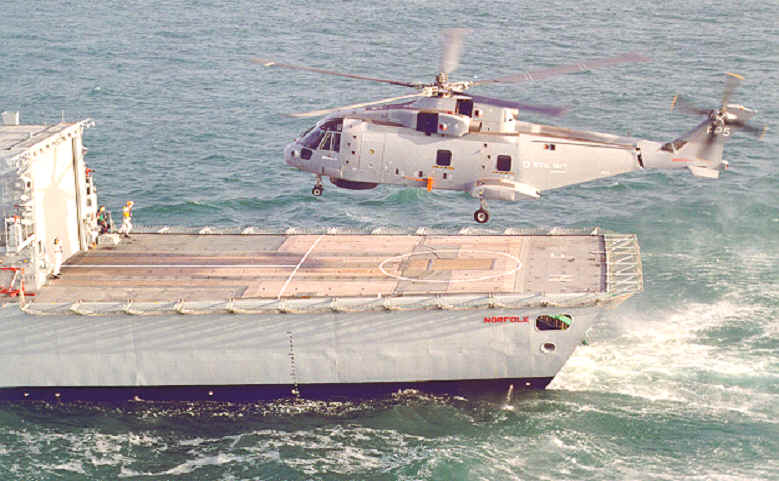
Flight Science & Technology Research Group
Flight Envelope Expansion through Modelling and Simulation
Department Home
Page
Courses
Simulation
Facilities
Feedback: mdw@liv.ac.uk
 The
qualification or certification processes of a new or upgraded
aircraft involve extensive flight testing to define the operational
flight envelope (OFE) and the service flight envelope (SFE). During
these processes, any aspects of the performance and handling of the
aircraft that need special pilot attention will also be exposed and
if acceptable to the operator, some limitations on the operational
capability can be defined within the OFE. It is the case that, in
practice, helicopters often take considerably longer than planned
to qualify to operational standard through this phase, largely due
to limited predictive capability in the present analytical design
methods. Improving predictive capability at the design stage aims
to reduce flight-testing time scales, increase test safety, and
avoid costly redesigns required to improve parameters or correct
deficiencies. This project is rooted in the area of improving the
prediction of helicopter behaviour
before the first flight through Modelling
and Simulation (M&S), with particular focus on the ability to
test, and thus expand, the boundaries of the flight envelope.
The
qualification or certification processes of a new or upgraded
aircraft involve extensive flight testing to define the operational
flight envelope (OFE) and the service flight envelope (SFE). During
these processes, any aspects of the performance and handling of the
aircraft that need special pilot attention will also be exposed and
if acceptable to the operator, some limitations on the operational
capability can be defined within the OFE. It is the case that, in
practice, helicopters often take considerably longer than planned
to qualify to operational standard through this phase, largely due
to limited predictive capability in the present analytical design
methods. Improving predictive capability at the design stage aims
to reduce flight-testing time scales, increase test safety, and
avoid costly redesigns required to improve parameters or correct
deficiencies. This project is rooted in the area of improving the
prediction of helicopter behaviour
before the first flight through Modelling
and Simulation (M&S), with particular focus on the ability to
test, and thus expand, the boundaries of the flight envelope.
The
extent to which modelling and simulation (M&S) can support the
qualification/certification process depends on the fidelity of the
M&S tools and facilities. Until relatively recently, the
fidelity of M&S tools has been considered satisfactory to guide
the testing (e.g. Ref 1) but inadequate for reducing flight test
hours in such aspects as flight envelope expansion, e.g. critical
azimuth testing, external load clearance. This project specifically
addresses the fidelity aspects of M&S in flight envelope
expansion and aims to develop a suite of tools, using the latest
simulation techniques, of a direct assistance in this process.

Of
particular interest is the use of inverse simulation methods to
predict the manoeuvre
performance requirements and task workload when flying mission task
elements (MTEs) (Ref 2). The concept of inverse simulation is not
new, and involves prescribing the flight path or manoeuvre
required to be flown and the resulting output is the prediction of
the pilot control activity and uncontrolled states. If the
manoeuvre is prescribed very tightly or requires high performance from the
aircraft, then there is a risk that the inverse pilot will not be
able to cope with the task and excursions outside the OFE/SFE or
pilot-induced-instabilities can result (Ref 3).
The
project will use recent developments in inverse simulation,
particularly the SYCOS algorithm (SYnthesis through COnstrained
Simulation) (Ref 4) to develop new procedures for supporting flight
envelope expansion. The SYCOS pilot model originated as an off-line
(desk top) simulation technique to evaluate rotorcraft performance
and handling qualities in standard manoeuvres such as the MTEs of
ADS33 (Ref 1). The outstanding factor of SYCOS above other inverse
simulation techniques is the ability of the model to respond to
disturbances (such as atmospheric turbulence) and constraints (such
as control limits) in a realistic human manner, where as pure
inverse simulation did not. In addition, pure inverse simulation
does not capture the compromises and trade-offs that a human pilot
makes when task demands are escalated, as they are at the limits of
the OFE. In application, the model has proved to be a significant
and reliable tool for piloting state-of-the-art rotorcraft
simulation.
The
flight simulator in the University of
Liverpool Flight Simulation Laboratory (FSL) will be used
extensively in conjunction with SYCOS as the Blackhawk, Lynx and
Bo105 helicopters are tested over ADS-33 based MTEs, enabling a
direct comparison between a range of off-line and piloted test
results.
The
areas of innovation in the project include:
-
develop an understanding of how to induce realistic pilot behaviour in SYCOS
-
develop algorithms for quantifying pilot workload
-
develop a method for simulating degraded visual conditions in the SYCOS approach
-
extend theory of Ref 4 to predict OFE exceedances
References:
-
Padfield, G.D., et al., Handling Qualities assessment of the UK Attack Helicopter Competition, 21st European Rotorcraft Forum, St Petersburg, Russia, Sept 1995
-
anon., Aeronautical Design Standard-33E-PRF, Performance Specification, Handling Qualities Requirements for Military Rotorcraft, US Army AMCOM, Redstone, Alabama, March 21, 2000.
-
Padfield, G.D., Charlton, M.T., Jones, J.P., Bradley, R., Where does the workload go when pilots attack manoeuvres?, 20th European Rotorcraft Forum, Amsterdam, The Netherlands, Sept 1994
-
Bradley, R., Brindley, G., Progress in the Development of a robust pilot model for the evaluation of rotorcraft performance, control strategy and pilot workload, 28th European Rotorcraft Forum, Bristol, UK, Sept 2002.
Members: